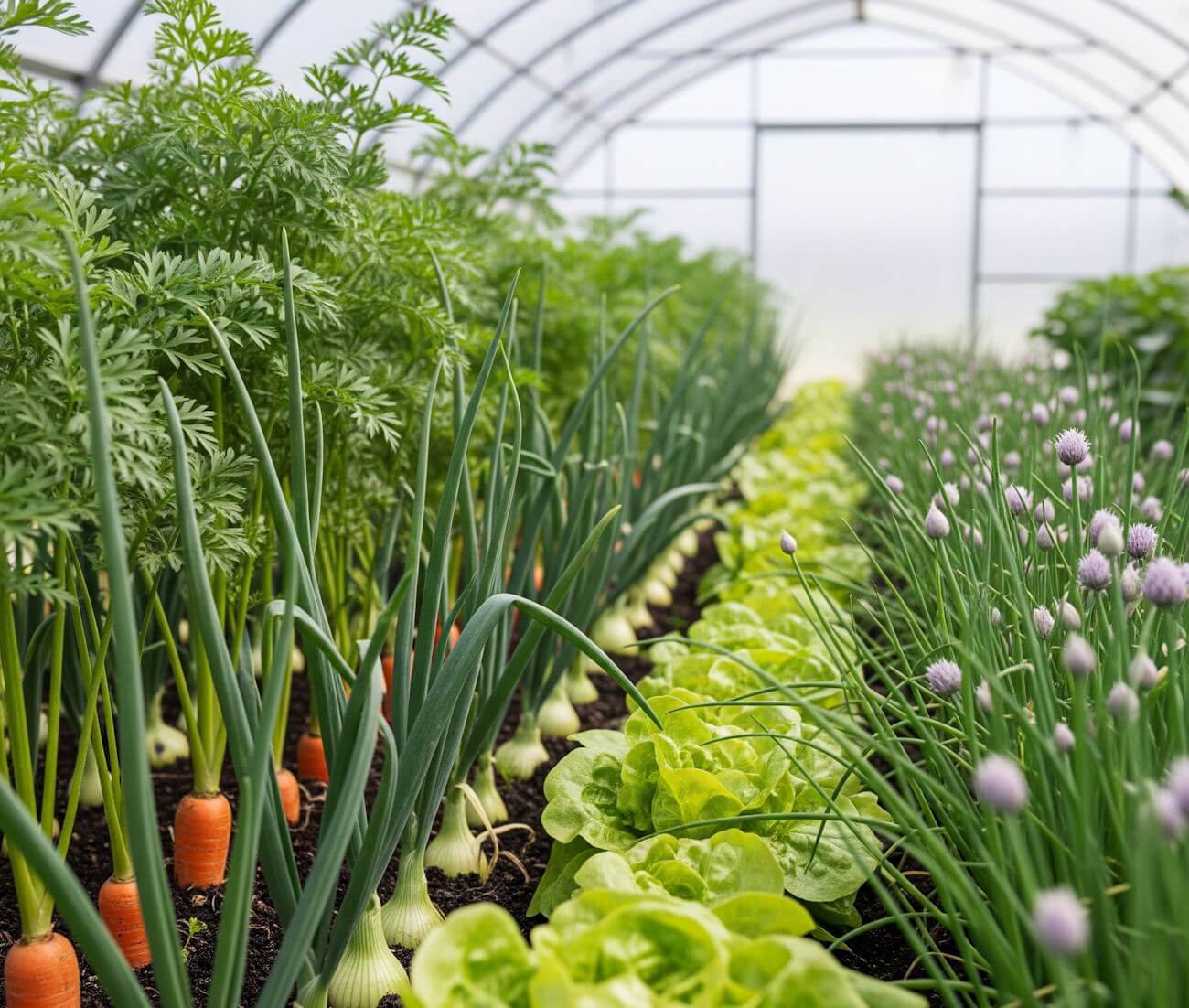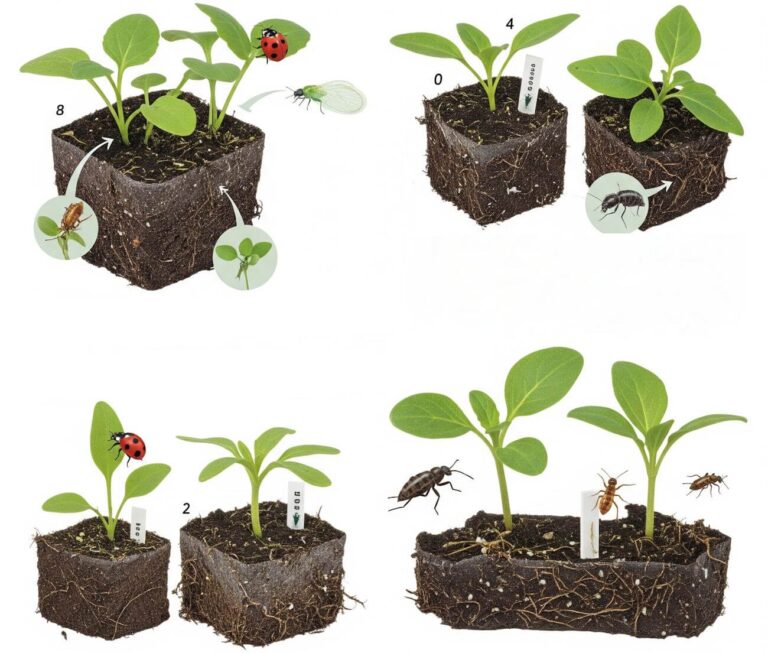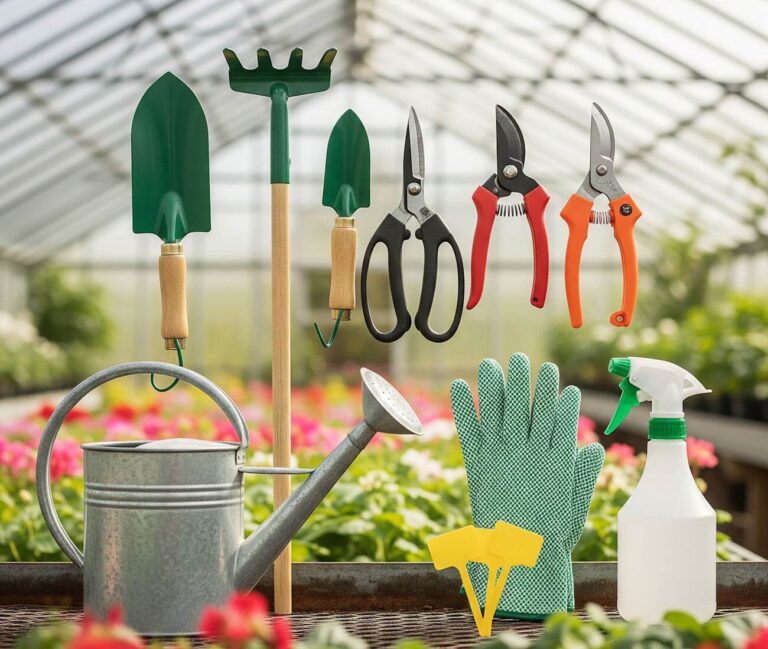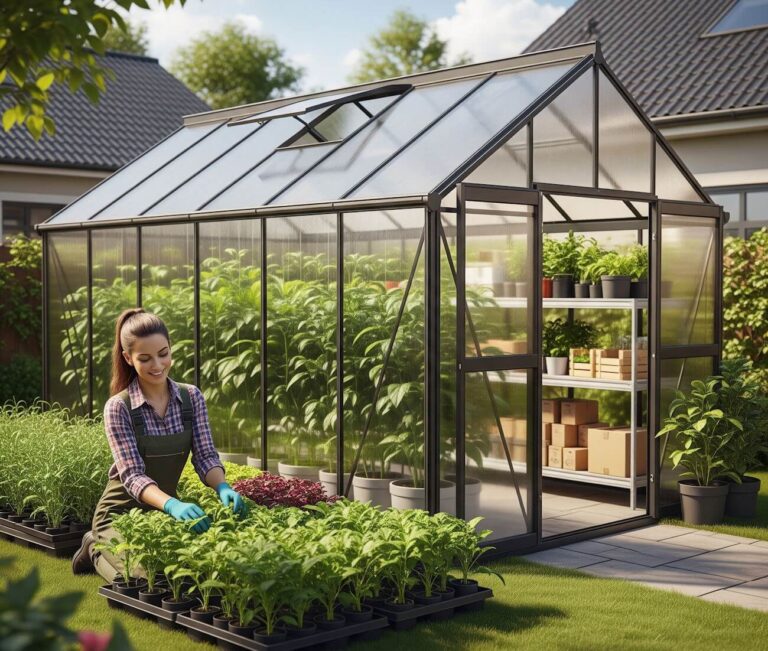Introduction to Companion Planting
Companion planting is a gardening technique that involves the strategic placement of different plant species in proximity to one another to achieve various beneficial outcomes. The underlying principle of companion planting is rooted in ecological interactions, where certain plants can enhance each other’s growth, deter pests, or even improve the overall health of the garden ecosystem. This practice serves to promote biodiversity within the planting environment and is particularly effective when implemented in a greenhouse setting, where conditions can be closely managed.
One of the key aspects of companion planting is pest control. Certain plants emit chemical compounds that can confuse or repel pests, making them invaluable partners in ensuring plant health. For example, the presence of marigolds is well-known for deterring nematodes and other harmful insects, thereby protecting neighboring crops. Additionally, companion plants can attract beneficial insects, such as pollinators and pest predators, that are essential for maintaining a balanced ecosystem within a greenhouse.
Another significant benefit of companion planting is nutrient enhancement. Some plant combinations can lead to improved soil fertility, as certain plants may fix nitrogen in the soil, benefiting their neighbors. Moreover, this practice helps to minimize competition for light, water, and nutrients, optimizing growth conditions for all involved species. The natural symbiosis created through careful selection and pairing can result in a more productive and efficient greenhouse environment.
In conclusion, the concept of companion planting offers an ecological approach to gardening that fosters harmony among plant species. By understanding how different plants interact and support one another, gardeners can create thriving greenhouses that prioritize both plant health and sustainable practices. This introduction lays the groundwork for exploring specific companion plant pairings that work effectively in greenhouse settings.
Benefits of Companion Planting in Greenhouses
Companion planting is a time-tested practice that offers numerous advantages, especially within the controlled environment of greenhouses. One of the key benefits is optimized space usage. In greenhouse settings, maximizing every inch of available space is essential for productivity. By strategically placing companion plants that have complementary growth habits, gardeners can efficiently utilize vertical and horizontal space, resulting in higher yields without necessitating additional square footage.
Another significant benefit of this technique is the enhancement of nutrient availability. Companion plants can exhibit varying nutrient needs, and when paired skillfully, they can help mitigate deficiencies. For instance, deep-rooted plants can draw up nutrients that are otherwise inaccessible to shallow-rooted plants, making them available at different soil levels. Such interactions foster a more nutrient-rich environment that supports plant health, ultimately leading to higher quality produce.
Natural pest deterrents also play a crucial role in companion planting. Certain plant combinations can repel pests without the need for chemical interventions. For example, fragrant herbs like basil planted among vegetables can mask their scent, making it more difficult for pests to locate their target. This creates a healthier growing environment and reduces the reliance on synthetic pesticides, which is particularly beneficial in greenhouses where plant health is paramount.
Moreover, companion plants can enhance pollination. In a greenhouse, the absence of natural pollinators can limit the reproductive success of flowering plants. By incorporating specific companion plants that attract pollinators, such as bees or butterflies, greenhouse operators can improve the pollination rates of their crops. This not only leads to more robust fruit and vegetable production but also contributes positively to the overall biodiversity within the greenhouse ecosystem.
Key Companion Plants and Their Combinations
In the world of greenhouse gardening, companion planting plays a pivotal role in establishing a thriving ecosystem. Certain plant combinations can significantly enhance growth, deter pests, and promote overall health. This section delves into popular companion plants, focusing on vegetables and herbs that work harmoniously together.
One classic pairing is tomatoes and basil. Basil not only enhances the flavor of tomatoes but also repels nematodes and aphids. This aromatic herb attracts pollinators and predatory insects, integrating seamlessly into greenhouse environments. Another beneficial duo is carrots and onions; the presence of onions can help stave off carrot flies, while carrots do not compete heavily with onions for nutrients.
In contrast, the combination of beans and corn exemplifies the “Three Sisters” planting method. Here, corn provides a natural support structure for climbing beans, while beans enhance soil nitrogen levels. Additionally, squash, with its broad leaves, can serve to shade the ground, suppressing weeds and preserving soil moisture. This trio demonstrates mutual benefit, illustrating how companion plants optimize greenhouse synergy.
Herb pairings also play a significant role in greenhouse cultivation. For instance, planting dill near cabbages serves the dual purpose of attracting beneficial insects and deterring cabbage moths. Additionally, rosemary can be an excellent companion for beans and carrots as its strong scent helps to mask the plants’ scent from pests. Conversely, some combinations, such as mint and cabbage, can be detrimental; mint can spread vigorously and overpower nearby plants.
In summary, understanding these influential relationships in companion planting equips greenhouse gardeners with the knowledge to design optimal plant pairings. Focusing on these synergistic combinations fosters a flourishing greenhouse ecosystem, ultimately contributing to a bountiful harvest.
Managing Space and Light in the Greenhouse
Effectively managing space and light is crucial for successful companion planting inside a greenhouse. The containment of plants within a greenhouse provides unique opportunities and challenges, particularly when it comes to optimizing these critical growth factors. By understanding how to utilize the available vertical space and maximizing light exposure, gardeners can enhance the productivity of their plant combinations.
Vertical gardening techniques are beneficial in a greenhouse setting, allowing for the cultivation of more plants in limited floor space. Utilizing shelves, hanging planters, and trellises can create layered growth systems. This not only accommodates a variety of plants but also encourages healthy air circulation and light penetration, which are vital for plant development. For instance, planting vine crops such as peas or cucumbers alongside lower-growing plants like lettuce can create a harmonious environment, where the taller plants do not overshadow their companions but instead support each other’s growth.
Another essential consideration is maximizing light exposure, especially for companions that thrive under full sun conditions. Positioning taller plants strategically can prevent them from blocking sunlight from their shorter neighbors. This necessitates a thoughtful arrangement based on the plants’ mature heights, ensuring that each type benefits from adequate light. Additionally, reflective materials can be employed within the greenhouse to enhance light distribution, promoting an even growth rate among companion plantings. It is also advisable to rotate the position of pots and planting beds within the greenhouse to adapt to shifting sunlight patterns throughout the seasons.
When implemented correctly, the interplay of light and space management not only optimizes companion planting success but also contributes to overall plant health. Observing how varying heights and canopy structures interact in the greenhouse will ultimately foster a thriving ecosystem, leading to higher yields and a healthier environment for plant growth.
Soil Health and Nutrient Considerations
Soil health is a critical component of successful companion planting in a greenhouse environment. A healthy soil ecosystem not only supports plant growth but also enhances the interactions between different plants. Each companion plant has specific nutrient requirements which can either compete with or complement each other depending on their growth habits and nutrient uptake. Understanding these requirements is essential for creating a balanced growth environment that promotes vigor among plant species.
Companion plants often contribute to soil amendment and enhancement through various means. For instance, legumes, such as clover or peas, have the ability to fix nitrogen in the soil, thereby enriching it for neighboring crops that require higher nitrogen levels. Additionally, deep-rooted plants can help break up compacted soil layers, facilitating better water infiltration and root penetration for shallow-rooted companions. This interaction not only improves the overall structure of the soil but also ensures that nutrients are more accessible to all plants involved.
To maintain optimal soil health, it is essential to conduct regular soil tests. These tests provide valuable insights into nutrient levels, pH balance, and microbial activity within the soil. Adjusting these aspects can significantly improve plant performance and yield. Organic amendments, such as compost, can be added to enhance both nutrient content and soil structure, creating a thriving ecosystem within the greenhouse. Furthermore, mulching can help retain moisture and suppress weeds, providing a favorable environment for companion plants to flourish.
In conclusion, focusing on soil health and nutrient considerations is vital for the success of companion planting. By understanding the specific requirements of various plants and employing methods to enhance soil quality, gardeners can create a more productive and sustainable growing environment in their greenhouses.
Pest Control Strategies Using Companion Planting
Companion planting within a greenhouse environment serves as an effective natural pest control strategy, allowing gardeners to manage unwanted pests while promoting the health of their plants. This method harnesses the relationships between various plant species, utilizing their unique attributes to deter pests and attract beneficial insects. Understanding which plants repel specific pests or encourage predatory insects is crucial for implementing an effective companion planting strategy.
For instance, marigolds are well-known for their ability to repel nematodes and aphids, making them an excellent companion for a variety of vegetables. When planted alongside tomatoes, marigolds help reduce populations of aphids that can cause significant damage to the tomato plants. Similarly, basil has been linked to repelling whiteflies and spider mites and thrives when planted near tomato plants, enhancing both growth and flavor while keeping pests at bay.
Moreover, planting dill near cabbage can ward off cabbage worms and attract beneficial wasps that prey on these pests. Additionally, the aromatic qualities of herbs such as mint and rosemary can deter a wide range of insects, allowing neighboring crops to flourish without the threat of infestation. The key to effective pest control through companion planting lies in understanding the pest dynamics at play within the greenhouse and strategically selecting compatible plants that create a resilient ecosystem. For example, interplanting garlic can deter aphids and spider mites due to its strong scent, while also benefiting neighboring crops through its pest-repelling qualities.
Overall, the thoughtful combination of plant species not only minimizes reliance on chemical pesticides but also enhances biodiversity within the greenhouse, contributing to a healthier growing environment. By leveraging the natural pest control capabilities of companion plants, growers can effectively manage common pest issues and foster a thriving, productive greenhouse. Through careful planning and observation, the benefits of companion planting as a pest management strategy can be fully realized.
Watering and Irrigation Techniques
Effective water management is crucial in a greenhouse, particularly when implementing companion planting techniques. Different plants exhibit varying levels of moisture requirements; therefore, understanding the specific needs of each species is vital to achieving optimal growth and yield. Overwatering can lead to root rot and other complications, while underwatering can stunt growth, making it essential to balance water application based on plant requirements.
One recommended approach is to group companion plants with similar water needs together. This method ensures that irrigation systems can be tailored to the requirements of these grouped plants, minimizing water wastage and increasing efficiency. For example, placing drought-resistant plants, such as succulents, alongside moisture-loving plants may lead to conflicting water needs, potentially harming one or both plant types.
The selection of an appropriate irrigation system is equally important. Drip irrigation is often favored in greenhouse environments for its precision and efficiency. This system delivers water directly at the plant’s roots, which minimizes evaporation and runoff. Additionally, it allows for the targeted application of nutrients, promoting healthy growth for companion plants. Alternatively, misting systems can be beneficial for plants that thrive in high humidity, creating an ideal microclimate within the greenhouse.
Monitoring the moisture levels in the soil using moisture sensors can provide valuable insights into when and how much to water. These sensors can help prevent overwatering, which is a common issue in greenhouse environments. Furthermore, understanding the impact of growing media on water retention is also crucial; for instance, a well-aerated potting mix may allow for better drainage, while heavier soils retain more moisture. By implementing tailored watering approaches, greenhouse gardeners can effectively nurture their companion planting initiatives, ensuring each plant reaches its full potential.
Seasonal Considerations for Companion Planting
Companion planting within a greenhouse environment is significantly influenced by seasonal changes, including temperature fluctuations, variations in light duration, and the physiological state of different plants throughout the year. Understanding these factors is essential to optimizing plant combinations and ensuring a successful yield.
During the spring months, greenhouse conditions often promote the robust growth of many plants. This season is particularly appropriate for pairing fast-growing crops, such as radishes and lettuce. These companion plants thrive in cooler temperatures and can help in maximizing space since radishes mature quickly, allowing other crops like lettuce to benefit from the space as they grow. Moreover, beneficial insects attracted by blooming plants, such as marigolds, can aid in pest control throughout the greenhouse.
As summer approaches, temperatures rise, leading to increased plant growth rates. At this time, consider planting taller varieties such as tomatoes alongside their companion plants, like basil and peppers. Basil can help repel pests while enhancing the flavor of tomatoes. Additionally, larger plants can provide shade for more delicate varieties, which may become stressed in excessive heat. Regular watering and attention to the humidity levels are imperative during these hotter months to maintain a balanced environment.
With the arrival of autumn, light duration begins to decrease. In preparation for this change, one may opt to plant cool-season crops, such as kale and spinach, which can tolerate lower temperatures. Pairing these greens with garlic can be beneficial, as garlic acts as a natural pest deterrent. Furthermore, plant rotation is essential in the fall to prevent soil nutrient depletion and to minimize the risk of pest and disease buildup across seasons.
In conclusion, tailoring companion planting strategies to the seasonal variations within a greenhouse can lead to healthier plants and more fruitful harvests. Adapting combinations based on temperature, light, and plant growth cycles ensures optimal performance throughout the year.
Case Studies and Practical Examples
Companion planting within greenhouses has proven to be an effective strategy for enhancing plant health and increasing yields. A notable case study can be observed in a greenhouse located in Oregon, where growers utilized the principles of companion planting to improve their tomato and basil crops. By planting basil alongside tomatoes, they reaped the benefits of basil’s natural pest-repelling qualities, which helped reduce aphid populations significantly, allowing the tomato plants to thrive in a healthier environment. Additionally, the aromatic properties of basil were found to enhance the flavor of tomatoes, further emphasizing the benefits of this plant pairing.
Another compelling example comes from a greenhouse operation in Florida that specialized in leafy greens. This grower opted to pair lettuce with radishes, employing a technique that maximizes space and optimizes growth conditions. The radishes, which mature quicker than the lettuce, not only served as a natural pest deterrent but also helped break up the soil, allowing for better aeration and nutrient access for the lettuce plants. The success of this planting combination led to not only a bountiful harvest but also a reduction in manual labor, as the radishes could be harvested earlier, thus providing room for the lettuce to expand.
In a more diverse greenhouse in California, the use of flowers such as marigolds alongside vegetable crops displayed noteworthy results. Marigolds are renowned for their ability to deter nematodes and other harmful pests. By integrating them with cucumbers and peppers, the growers noticed a marked decrease in pest attrition. Furthermore, the visually appealing combination attracted beneficial pollinators, thus ensuring a healthier pollination rate for their crops. Each of these examples illustrates that thoughtful plant combinations and techniques can lead to increased productivity and biodiversity within greenhouse settings, promoting an ecological balance and enhancing overall plant performance.
Conclusion and Best Practices
In summary, companion planting within a greenhouse setting can significantly enhance plant health, boost yields, and reduce pest issues. The fundamental principles explored demonstrate the importance of plant relationships, with mutual benefits such as improved nutrient uptake, natural pest control, and enhanced resilience. Some plants thrive in proximity, while others may compete for resources, underscoring the necessity for careful selection. Understanding these dynamics allows for the effective integration of companion plants, which not only promotes biodiversity but also creates a more balanced and productive greenhouse ecosystem.
For successful implementation of companion planting, consider the following best practices: First, familiarize yourself with the specific needs of your plants. Understanding water, light, and nutrient requirements are foundational to effective pairing. Second, use pest-repellent companions, such as marigolds, alongside vulnerable crops to create a natural deterrent. This strategy leverages the pests’ aversion to the scent and properties of the companion plants, providing organic pest control. Third, experiment with various combinations as every greenhouse environment presents unique challenges and opportunities. Keep detailed records of your planting arrangements and their outcomes to identify winning combinations and inform future plantings.
Additionally, embrace the diversity of crops. Growing a variety of plants not only attracts beneficial insects but also minimizes the risk of disease and pest outbreaks. This can be achieved through intercropping or using successive planting techniques. Lastly, invest in continuous learning; gardening practices evolve, and staying informed about new research can further enhance your companion planting strategies. The approach of adapting, observing, and evolving is vital for fostering a thriving greenhouse environment.
By applying these best practices, gardeners can maximize the benefits of companion planting, leading to a more fruitful endeavor within the greenhouse. Experimentation, observation, and adaptation are key components in the journey towards successful indoor gardening.







